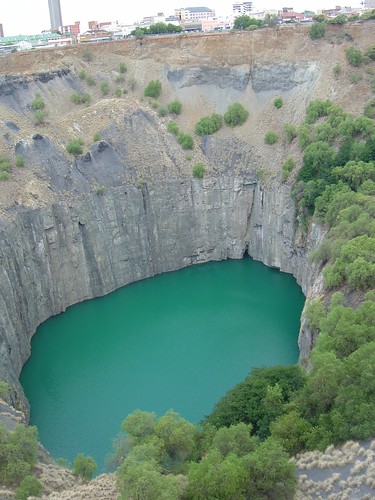
So last week I ranted about how I wasn't too impressed with the diamond exhibit. Well, after stopping off at the bat cave and realizing I'm just too old to find it as cool as I once did (and gaining a desire to hide in its darkness and jump out and scare kids) I decided to head up to the top floor to check out the ROM's secondary temporary exhibit, "Ancient Ukraine: Mysteries of the Trypillian Culture". I wasn't really expecting much, but the exhibit turned out to be the highlight of my visit.
The term "Trypillian culture" refers to the culture (inferred from tangible archeological finds) of a neolithic populous living in the Ukraine (what today lies in Ukraine/Moldova/Romania). The term itself comes from "Trypillia", a Ukrainian village near Kiev, where the first indications of this neolithic culture were found. This culture is thought to have flourished between 5500 and 2750 BC, and has several quirks that distinguish it from other neolithic cultures.
While Trypillians had much in common with other neolithic cultures (stone tools, decorated pottery, ceramic totems, wooden and straw houses, a focus on farming), certian aspects of their societies differed from others. Most notably is their tendency (perhaps defining characeristic) to live in large groups of settlements and build houses much larger than is normal for their groups of their population. The exhibit seemed to describe these large enclosed areas as not cities, but rather "giant settlements", wherein Trypillians would dwell for some time, before burning them to the ground and abandoning them, never to return again. This is one of the chief "mysteries" of the Trypillians, which apparently confounds modern archeologists.
The exhibit itself, unlike "The Nature of Diamonds", was well organized. It mostly consisted of pottery, ceramic objects, models of a Trypillian mega-settlement and house, and a few other stone-age objects (such as "venus" figures) thrown in, to give the viewer some chronological context. It also had a short movie, brief, but relatively informative and well-done. The exhibit had no central object, unlike the diamond exhibit, and thus inspecting the objects and reading about them was more accessible, despite the smaller floorspace alloted to the exhibit. I never felt rushed and had plenty of time to find out as much as I wanted about these ancient people and their agricultural practices, farm live, and their magnificent pottery.

Some highlights of the exhibit were the pots crafted by the Trypillians, created without a potter's wheel, and decorated with dark spirals. I was also a huge fan of their ceramic animals, such as the tiny bovies, especially a cow-bowl, a little bowl with legs, a head, and a tail. Archeologists seem unsure of what these were for (as well as the dozens of bovine figures, which the exhibit suggests were perhaps toys), but they're even less certain of the "binoculars" - two hollow cylinders tied together (pictured above) - were intended for.

One downside of the exhibit were the large pictures drawn to exhibit Trypillian life. These were pretty cheezy and seemed a little more like "bible story" pictures from some kid's book than a serious attempt at depicting an ancient people. My favourte remains an image of a Trypillian potter, a tall, slender woman, her primitive clothing barely draped over her breasts, holding her baked "binoculars" high, the moon and the stars shining in the background. I mean, come on. Seriously.
Anyway, the exhibit was pretty good, combing and I'd recommend it to anyone looking to learn a thing or two about a people long since vanished. It's not the bat cave, but the kids might even get a kick out of checking out these old pots. It's not the bat cave, or even the T-Rex, but hey, it's interesting, and, in the long run, a lot more educational.





